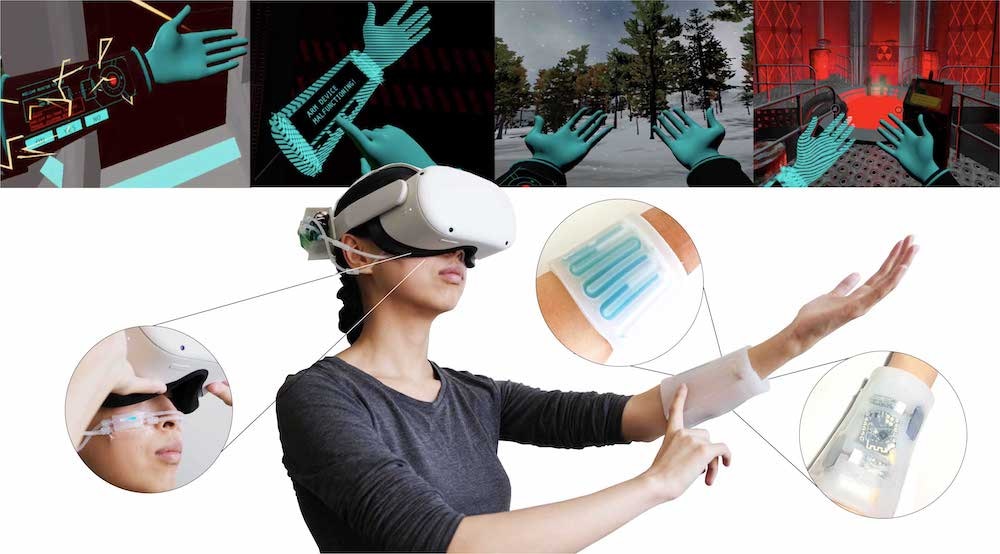Create a free profile to get unlimited access to exclusive videos, sweepstakes, and more!
From temperature to pain, wearable chemical haptics deliver more immersive VR
Maybe some games don't need a more immersive experience.

Pop culture has been promising us immersive virtual reality for decades and, so far at least, available virtual experiences haven’t quite lived up to our expectations. In recent years the adoption of virtual reality in the home and at dedicated sites has brought with them renewed interest and hope in the medium; one recent advancement could help make virtual lives a little more realistic.
In a recent paper published by Jasmine Lu and colleagues at the University of Chicago, researchers explored the functionality of a wearable containing chemical haptics for generating a more robust virtual experience.
Using well-known, over the counter chemical agents, the team developed wearable devices which could be placed on the arm and cheeks of a user to deliver chemical stimuli simulating various tactile experiences. They targeted five specific responses, those of heat, cold, stinging, tingling, and numbing. The user feedback was variable, depending on the sensation being delivered, but overall participants noted a more immersive VR experience.
“They are realistic in the sense that they are targeting the same receptors in the body that usually respond to these sensations,” Lu told SYFY WIRE. In certain circumstances, like those of temperature, the haptics seem to provide a less than totally immersive experience largely because they are targeting specific regions instead of the whole body.
Players of the team’s virtual game might walk into an area where they’re being blasted with frigid winds and the wearable will then deliver menthol to the cheeks. There’s a feeling of cold in that region, but not over the whole body as would be expected in an actual blizzard. A similar scenario is also true of the heat from a digital nuclear meltdown. Users did note, however, that the stinging sensation was particularly effective.
“We got feedback from users that they felt like they had a flesh wound and a feeling of burning,” Lu said. “On the other end of the spectrum, numbing is one of the hardest because it’s numbing locally.”
The team created their own novel simulations in order to test the effectiveness of each of the five sensations. Then they put them all together so individuals could experience all five in a continuous narrative.
Players are put into a story wherein there is a nuclear meltdown happening and they have to attempt to stop it through the use of an arm-mounted interface which mirrors the wearable they’re wearing in the real world. As they move through the story the interface begins malfunctioning. This gave the game designers an opportunity to experiment with electrical sparks and temperatures as players move through the game.
“At one point the interface becomes sort of transparent like the arm isn’t quite there. That’s when the numbing comes in,” Lu said. Lidocane applied directly to the skin through the wearable then numbs the local area, reinforcing the visual stimuli that their arm has become intangible.
For this study, the team specifically chose compounds which were readily available and had a long history of use in people. Looking forward, they’re interested in mixing compounds and experimenting with additional chemicals to develop even more sensations for use in VR.
“One thing I find really interesting about this is we’re kind of blending the device and our bodies, because we’re targeting our own biological mechanisms to produce sensations, rather than using an external technology to create haptics,” Lu said.
At present, the technology is not ready for commercial use, but Lu is interested in its use for training scenarios related to safety protocols. “Being able to simulate those sensations that are more unsavory while going through a safety protocol might be more effective than just a visual guide,” Lu said.
The future of chemical haptics need not be all negative sensation, adding the ability to feel temperature while playing games would add to the immersion and enjoyment of playing, without needing to feel like your arm is being torn open.
“Imagine being able to play something like Animal Crossing and feel when it starts to snow,” Lu said.
That sounds like an incredible way to spend an evening. We can’t wait.


























